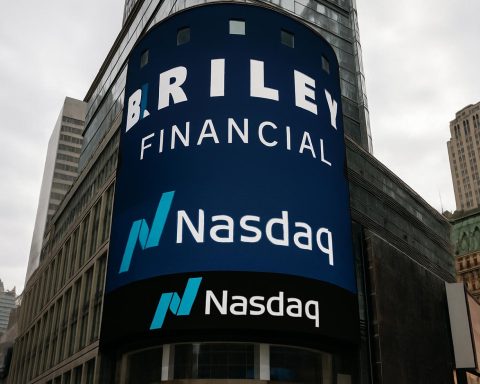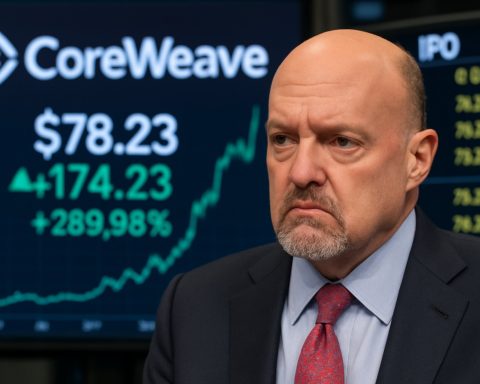- Vroom, Inc. (NASDAQ:VRM) has transformed from a struggling e-commerce model to a thriving automotive finance and AI analytics leader.
- The company successfully emerged from Chapter 11 bankruptcy, eliminating $290 million in debt and restructuring its equity, which led to a 643.08% stock surge in 2025.
- Vroom’s relisting on the Nasdaq Global Market restored investor confidence and created new opportunities.
- Focused on its subsidiaries, United Auto Credit Corporation (UACC) and CarStory, Vroom is positioned to capitalize on increased consumer demand for auto finance and analytics, especially as vehicle ages reach record highs.
- The broader market trend toward AI-driven growth continues, with tech-savvy investors seeking the next opportunity in this high-potential sector.
- Vroom’s journey showcases how strategic reinvention and technological integration can drive success, even amidst economic challenges.
Amidst the turbulence of high interest rates and shifting global economic policies, certain sectors continue to defy expectations. The automotive industry, often vulnerable to economic fluctuations, presents a striking narrative in 2025. Particularly remarkable is the story of Vroom, Inc. (NASDAQ:VRM)—a company that has not only weathered financial storms but emerged as a robust contender in the vehicles and parts market.
Vroom, known for its bold pivot away from the struggling e-commerce model, has redefined itself into an influential automotive finance and artificial intelligence analytics powerhouse. Through its subsidiaries, United Auto Credit Corporation (UACC) and CarStory, Vroom is leveraging technology to enhance auto lending and provide cutting-edge insights into vehicle markets.
A pivotal moment for Vroom arrived with its successful exit from Chapter 11 bankruptcy. This restructuring discharged a significant $290 million in debt and led to a complete overhaul of its equity structure. The reward for such financial gymnastics? An impressive year-to-date stock surge of 643.08%, a feat that few had predicted.
This leap was magnified by Vroom’s relisting on the Nasdaq Global Market under its original VRM ticker. Reinstating investor confidence and opening the gates to new opportunities, this relisting marked a new chapter for the company. As it now stands, Vroom’s strategic move from a capital-heavy retail model to focusing on its UACC and CarStory divisions creates a promising path toward profitability.
The driving force behind these changes is the ongoing trend where consumers, squeezed by economic pressures and record-high vehicle ages, opt to maintain and repair existing cars rather than purchase new ones. Vroom’s auto finance and analytical services are well-aligned with this shift, positioning it advantageously in the ever-evolving automotive landscape.
Yet, while Vroom dazzles with its turnaround, it’s the broader market trends that invite contemplation. The appeal of AI-driven stocks is undeniable, capturing the imagination of investors seeking transformative growth. Even though VRM leads in its category, tech-savvy investors are on the lookout for the next big opportunity in AI—a domain bursting with potential and poised to deliver exponential returns.
The story of Vroom in 2025 is one of resilience, strategic reinvention, and the promise of technological integration. It’s a reminder that even in unfavorable economic climates, innovation and adaptability can carve paths to success. For investors and industry watchers alike, Vroom exemplifies the unexpected victories possible when companies dare to navigate uncharted roads.
Vroom, Inc.: Reinventing Wheels and Strategies Amidst Economic Shifts
The Evolution of Vroom, Inc. in a Changing Auto Industry
In the dynamic landscape of the automotive industry, Vroom, Inc. (NASDAQ: VRM) stands out as a testament to resilience and strategic reinvention. Navigating through high interest rates and evolving global economic policies, Vroom has emerged stronger, cementing its place as an influential player in 2025. This success story is built on their strategic shift from e-commerce to automotive finance and artificial intelligence analytics, positioning them attractively in the market through subsidiaries like United Auto Credit Corporation (UACC) and CarStory.
Key Developments and Strategies
1. Strategic Shift and Exit from Bankruptcy
Vroom’s strategic exit from Chapter 11 bankruptcy, which erased $290 million in debt, revitalized their financial standing. This intricate financial restructuring, combined with a relisting on the Nasdaq Global Market under the VRM ticker, breathed new life into investor confidence, contributing to a stock appreciation of 643.08% year-to-date.
2. Focus on AI and Financial Solutions
By pivoting away from a capital-intensive retail model to a technology-focused approach, Vroom is leveraging AI to enhance auto lending and market insight capabilities. This revolutionary change comes at a time when consumers prefer maintaining and repairing vehicles due to economic pressures, giving Vroom’s services increased relevance.
3. Capitalizing on AI Trends
Their shift towards AI analytics not only aligns with current consumer behaviors but also taps into the growing investor appetite for AI-driven stocks. With AI reshaping various industries, Vroom’s tech-centric approach appeals to investors looking for exponential growth potential.
Real-World Use Cases and Market Trends
– Auto Finance Demand: In a climate where new car purchases are often deferred, Vroom’s finance solutions serve as vital tools for many consumers needing vehicle upkeep or refinancing.
– AI in Automotive Analytics: AI-driven insights provided by CarStory offer a competitive edge in understanding vehicle market trends, forecasting supply and demand, and determining optimal pricing strategies, which are invaluable for manufacturers and dealers.
Reviewing Vroom’s Competitors
Although Vroom is a significant player, other companies are also innovating in the AI and auto finance sectors:
– Carvana: Primarily focused on e-commerce, Carvana offers a platform for buying and selling cars but is expanding its footprint in finance.
– Shift Technologies: Similar to Vroom, Shift is optimizing operations and has seen some pivots toward technology and finance to boost profitability.
Pros and Cons Overview
Pros
– Impressive stock performance and restructuring boost.
– Advanced AI solutions in auto finance and analytics positioning them uniquely in the industry.
– Responsive to economic trends affecting consumer behavior.
Cons
– Exiting bankruptcy, while beneficial, portrays a risky past that might concern some investors.
– Strong competition potentially diluting market share despite innovative pivots.
Predictions and Future Insights
As Vroom continues to focus on integrating technology with financial services, the automotive industry is expected to see further AI-driven innovations. Emerging trends such as autonomous vehicles and the shift toward electric vehicles will provide additional opportunities and challenges.
Actionable Recommendations
1. For Investors: Consider diversified investments in companies leveraging AI in their transformation strategies, not only in the auto industry but also other sectors like healthcare and finance.
2. For Consumers: Explore the benefits of auto financing solutions that utilize AI for personalized loan offerings and predictive maintenance insights.
Conclusion
Vroom’s journey showcases the power of innovation and adaptability in difficult economic climates. As AI continues to evolve, Vroom remains a company to watch, offering valuable lessons on strategic transformation. Stay informed about the automotive industry’s future by exploring resources from credible platforms like Vroom.












